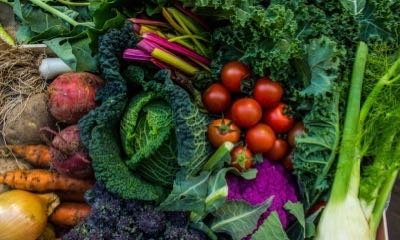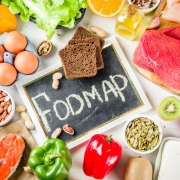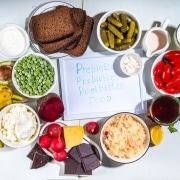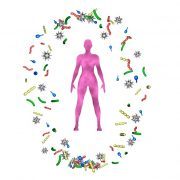Growing Your Gut Garden—What to Feed Your Gut Microbiota
You’re a gardener—even if you don’t have the green thumb to prove it. You may never have planted a seed and cared for it until it sprouts from the earth. But you’re still a gardener of sorts. That’s because your gut is like a garden and your diet acts as the soil and fertilizer.
What you put into your garden influences your microbiota (the microbes that grow there). Specifically, the mix of fiber, protein, carbohydrates, fat, and micronutrients in your diet determines whether your microbiome will flourish.
The microscopic residents of your gut include fungi, viruses, yeast, and other microorganisms. But bacteria are the most notable gut flora. Because their lifespan is short, bacteria can adapt to environmental changes rapidly. They can also take genetic material from neighboring gut flora, which can benefit both bacteria and the host they live in (you!).
These characteristics are what make bacteria so impactful on human health. And that’s why it’s important to understand how your diet cultivates the health and diversity of bacteria and other gut flora.
How Your Gut Garden Started
You weren’t born with the bacteria you now have in your gut. This profile was built over the initial years of your life, starting with the way you were born. Cesarean versus vaginal delivery dictated the initial dominant bacteria in your gut. Then, what you were fed rounded out your gut’s early bacterial profile.
Studies on mother’s milk really illustrated the role and importance of gut microbiota. Researchers initially were unsure why the milk contained such complex carbohydrates. These molecules were known to be indigestible for infants. The babies lacked the necessary enzymes. However, early research revealed the complex carbohydrates are actually present in mother’s milk to nourish the infant’s gut microbiota, and not the infant.
So, your gut garden began at this early stage in life. Mother’s milk acted as the rich soil that nourishes bacteria within. The result was symbiotic for the bacteria and baby. The bacteria flourished, and in doing so, protected the baby’s gut lining. This was important for healthy immunity and nutrient absorption—and remains important as an adult. Proliferation of good bacteria meant they can crowd out possible pathogens and break down the complex carbohydrates into digestible parts.
After your first two years of life, your microbiome’s profile was nearly set. And even with all the variety in flora, lifestyle, genetics, and anatomy, there are some bacteria typically found in the gut microflora.
The most common types of bacteria found in the human gut belong to the phyla firmicutes and bacteroidetes, actinobacteria, and proteobacteria. These phyla (a biological classification) contain bacterial species you may have heard of before, like Lactobacillus, Prevotella, Bifidobacteria, and H. pylori.
There has been a concerted effort to extensively analyze the human microbiome. More research needs to be done before one profile is proclaimed the healthiest. But even with a lack of definitive answers, an educated conclusion can still be made.
One confirmed characteristic of a healthy gut is a diversity of microflora. Diverse bacterial communities tend to be more resilient. This means they’re better at fending off potential pathogens that might invade and try to take over space. When the gut microbiota is filled with a plethora of various good bacteria, the bad kind don’t have empty space to take up residence.
This is a constant battle for space and resources. And you play a big role. As the gardener, you control the soil and fertilizer, which determines what grows best. That’s where what you choose to eat comes into play.
How Your Diet Affects Your Gut Microbiome
Research shows differences in microbial profile exist based on the content of your current diet—just like the differences explained by feeding mother’s milk versus formula. That means a diet rich in fruits and vegetables (which contains more fiber) will produce a different bacterial profile than one rich in animal protein and fat, or another full of simple and processed carbohydrates.
But what kind of dietary soil grows the most diverse and robust gut-flora garden? And which diets fail to yield advantageous bacterial profiles?
The table below will give you an idea of how gut microbiota shifts with different diets. You don’t need to be an expert on the different bacteria listed below to get an idea of that key characteristic of a healthy gut—diversity.
| Increasing Species | Decreasing Species | Diversity | |
| Western diet | Bacteroides | Bifidobacteria | Less |
|
Mediterranean diet |
Bifidobacteria
Lactobacilli Prevotella |
More |
|
|
Vegetarian diet |
Bifidobacterium
Lactobacillus Prevotella |
Bacteroides |
More |
Western Diet
This type of diet is high in saturated fat and sugar, and it features processed foods. Because it lacks a variety of fruits and vegetables, the modern Western diet lacks fiber. If you remember from earlier, fiber is what feeds your gut microbiota. That’s why fiber is often called a “prebiotic.” That’s because it feeds the bacteria that ultimately help nourish you.
Without that fiber, there are fewer species of flora in your gut that can thrive. This means microbial diversity is less than with other diets rich in fiber from fruits, vegetables, and whole grains. Decreased microbial diversity leads to decreased gut resilience, which can spell problems for your health.
Mediterranean Diet
On the other hand, the Mediterranean diet is known for healthy variety. That includes:
- Various fruits and vegetables
- The inclusion of legumes and whole grains
- A generous use of healthy fats—like olive oil
- Minimal intake of animal-based proteins
This mix creates a diet rich in fiber—or prebiotic material—that your gut microbiota literally lives for. And, as you might have guessed, the Mediterranean diet promotes microbial diversity. One review of diet-induced microbial changes noted no decreasing species in those who consumed a Mediterranean diet. On the other hand, researchers noticed an uptick in at least three species.
Not convinced? One study focused on a group of Italian participants who ate a Mediterranean diet. Over the course of three weeks, the participants provided three samples that were pooled and analyzed for gut microbial content. The researchers found those who best adhered to the diet had more diverse flora in their guts. More specifically, in plant-based eaters (no animal-based protein), they found an increase in Prevotella bacteria.
Vegetarian
Eating vegetarian yields increases in similar bacteria found in adherents of the Mediterranean diet. Additionally, vegetarian diets also cause an uptick in diversity of microbiota, thanks to all that vegetable-based fiber.
Another notable shift is the decrease in Bacteroides species—the opposite trend seen in Western diets. The main difference is the consumption of animal-based protein. Bacteroides are not inherently bad, and can have a beneficial relationship with the gut. But, should they escape that environment through the gut lining, they can cause issues.
You (And Your Gut Microbiota) Are What You Eat
There’s still much research to be done on the gut microbiome and all of its intricacies. But some things are very clear.
First, you gut microbiota’s health is inherently tied to your overall health. One of the main reasons? Your gut flora help digest food and nourish your body. They also play a role in signaling the brain with various messages, like when we’re hungry or adequately satiated. And flora also play a role in maintaining healthy immunity.
Second, it’s established that you should strive for diversity of microbiota in your gut. And before you worry, there’s no need to completely overhaul your diet to achieve this goal. Instead, start by thinking about ways you can incorporate more fiber into your diet.
Luckily, you have a lot of options for doing so. Try a few of these easy options:
- Make small, easily applied changes. Like swapping out rolled oats for steel-cut oatmeal. Or eating whole-wheat pasta al dente versus cooked soft. Feeding yourself whole grains that take a little more effort to digest means you’re giving your microbiota more fiber to chew through.
- Consider replacing a processed snack with fruits or vegetables. And you can make it fun! Apples or carrots can be more exciting when paired with your favorite nut butter. A salad also tastes brighter with fresh strawberries.
- Skip the peeler when you can. Vegetable and fruit skin (or peels) can have a lot of healthy fiber and nutrients. When you peel them away, you miss the nourishment they provide you and your microbiota.
- Take a wholly different approach to grains. Love white bread and other grains? You’re not alone. But substituting a serving here or there for a whole-grain option is a good start. Try a multigrain bread, whole-grain pasta, or a new grain altogether (bulgur, quinoa, farro, or brown rice). It can spice up your cooking routine and help your gut.
Lastly, consider easing up on antibacterial soaps and ideology. You want to keep pathogens away from your homes and bodies. But it’s easy to go overboard when it comes to cleanliness. This might mean not washing your hands after petting your dog, or making sure you really need antibiotics before taking them. The common cold is caused by a virus, so you won’t benefit from antibiotics.
The state (and diversity) of your gut microbiota is fairly stable in adulthood, but that’s not the case when you take antibiotics. They can wipe out bad and good bacteria. That’s like depleting a garden of all its organic material, richness, and nutrients at once. And that wonderful, fertile microbial soil will need to be rebuilt. One study found that it can take up to four weeks for your gut microbiota to return to its normal diversity.
Now that you’re in the know when it comes to your microbiota, you can trust yourself to be a master gut gardener. Whether your soil isn’t where you want it to be or not, you have the knowledge and tools to make changes and grow a healthy gut microbiota garden that can benefit your health.
About the Author
Jenna Templeton is a health educator and freelance science writer living in Salt Lake City, Utah. After receiving a bachelor of science degree in chemistry from Virginia Tech, Jenna spent five years as a research scientist in the nutritional industry. This work fueled her interest in personal wellness, leading her to pursue a graduate degree in Health Promotion & Education from the University of Utah. Outside of work, Jenna enjoys live music, gardening, all things food, and playing in the Wasatch mountains.
References
https://www.ncbi.nlm.nih.gov/pmc/articles/PMC3427212/
https://www.ncbi.nlm.nih.gov/pmc/articles/PMC2937523/
https://www.ncbi.nlm.nih.gov/pmc/articles/PMC6351938/
https://www.sciencedirect.com/science/article/pii/B9780128039687000241
https://www.ncbi.nlm.nih.gov/pmc/articles/PMC5385025/
https://gut.bmj.com/content/65/11/1812.full

















